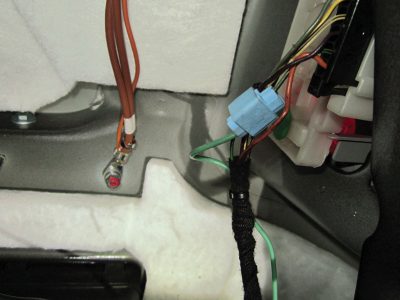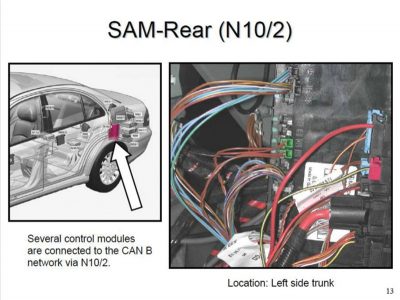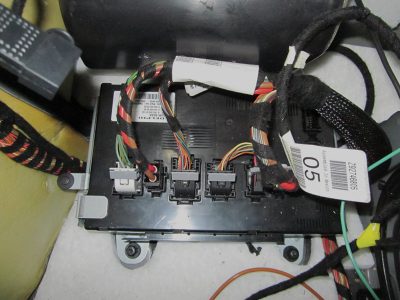These modules have been in production since just before the turn of the century, but if you still don’t understand their functions diagnosis will be more difficult than it has to be.
In the world of Mercedes-Benz, the acronym “SAM” is commonly thrown around by technicians. Truthfully, we think many of them either A: Don’t know what the acronym actually stands for, or B: Have no idea (or at least only a vague one) of the functions it performs. So, let’s bring out Mr. SAM and meet him.
SAM stands for Signal Acquisition Module, and it’s a controller with multiple functions. Part of the vehicle Controller Area Network (CAN), a SAM acts much as a router does in a communications network. Depending on the application, the number of SAM units per vehicle can vary from one (found on early W202 C-Class and W210 E-Class), to today’s models, which have multiple units. With the SAM’s multiplexing capabilities, it’s more than just a Signal Acquisition Module. In reality, it’s a Signal Acquisition and Actuation Module with the ability to receive data from various sensors, switches, and controllers, and also send data, monitor for faults, and actuate various components both analog and digitally.
Being that it’s part of the CAN system, its basic principles of operation are the same as other controllers in the network. The SAM has to follow the same protocols, meaning the system rules for data exchange used on the familiar CAN data bus system designed by Mercedes-Benz. Because of its integration as part of the CAN system, if you have yet to grasp the fundamentals of Mercedes-Benz network operation and how the various controllers interact with each other, you will have a difficult time troubleshooting problems that involve the SAM.
Often described as a computerized fuse box, SAM modules come in two different configurations with one version having an integrated fuse and relay box attached, and the second as a stand-alone controller. If the SAM is a stand-alone configuration, it’s mounted very near a separate fuse box assembly.
Advantages of design
- The SAM module has the ability to combine many different controllers into one compact unit. This design cuts weight, is more energy efficient, and reduces the number of connectors.
- Using a SAM in conjunction with a fuse box allows it to convert digital signals back into analog form for conventional relay actuation.
- The SAM has multi-channel capabilities that make it expandable for Mercedes-Benz to add new technologies in the future, or reconfigure existing operations if needed.
- The SAM platform allows the same basic hardware to be used in different product lines with minimal change. This makes manufacturing more efficient and ultimately provides for a more reliable part.
Inner Workings
Lets look deeper into a SAM; for this article we will focus on a rear SAM, but the same principles are applied to all SAM modules. Three different modes of operation are possible depending on what action is needed:
- Data receiver and transmitter on the CAN network: This includes scanning of switches, pickups, and sensors. The SAM captures this information and reports it to the appropriate receiver on the CAN network. An example would be fuel level senders reporting the amount of fuel in the tank. The SAM simply takes the reading and reports it to the instrument cluster. But why not simply connect the fuel sender to the cluster itself as was done in the past? Well, it’s more efficient to connect it to the rear SAM since it’s the closest point to get the signal on the CAN. This saves us from un-needed wiring, and now the signal can’t only be used by the cluster, but by any other controller on the network that may need it.
- Digital to analog signal conversion: We’ll use the rear window defroster as our example. The command to defrost is sent from the climate control switch in digital form to the SAM. The SAM interprets this signal and then sends an analog voltage to the defrost relay, engaging it and turning on power to the heating element on the window.
- Pulse width modulation, or PWM (as discussed in detail in the last issue of StarTuned®): Let’s take a late-model with LED taillights as our example here. A signal to switch on the parking light is put on the CAN network by the lamp switch. The SAM receives the message and in turn sends the appropriate PWM voltage to the lamps.
Sure, Let’s Blame SAM
|
GF54.21-P-4155-01AK |
SAM control unit, task |
GeneralTo allow data to be exchanged, the SAM control unit (N10) is connected to the Controller Area Network bus class B (interior) (CAN-B). The SAM control unit (N10) is connected to the relay and fuse box (K100) in which relays and fuses are integrated. The appropriate consumers are actuated and protected by means of these relays and fuses. |
|
|
Mercedes-Benz’s definition of SAM function as stated in WIS. |
|
- The first course of action in any diagnosis should be to pull codes by running a quick test on all systems with Mercedes-Benz diagnostic equipment or equivalent. By running a test on ALL systems, you may be able to determine if you have a single issue or multiple problems related to the same single source. For instance, a SAM that has no communication would send you in the direction of checking for power and ground at the unit.
- If codes are present, running the guided test for the given fault is needed, along with a check for any associated service bulletins.
- Checking live data for a signal command and actuations of the affected part could be of great benefit in the diagnostic process.
- If at this point there has been no positive result, it’s time to look at both function and wiring diagrams of the affected system. Without diagrams, at this point you’re just guessing. Diagrams are located in the Mercedes-Benz WIS, on-line if you’re a StarTek info subscriber, or are available from some aftermarket services. Armed with diagrams you should be able to determine if the circuit in question is digital or analog, and then use the appropriate tools and techniques for testing.

Since SAM use started in the late ‘90s, they’ve been around long enough for us to have seen some common problems. This is especially true with rear SAM controllers. It’s been our experience over the years that if a SAM has failed, it was usually because of unusual circumstances. Several instances come to mind that may be helpful to you in the future:
- Circuits connected to the SAM that have a higher-than-normal amp draw: We’ve seen in the shop where high draw through the SAM from a fuel pump, window heater, lift gates, or rear shades has melted connectors and pins in the SAM. In these cases, the electrical consumer needs to be checked for excessive draw, along with repairing the connector and replacing the SAM.
- Broken wires, especially in high wear areas (i.e. hinges): These sometimes lead to shorts that damage internal circuitry.
- Several SUVs have made their way into the service bay with lighting issues, and after some testing we find someone has spliced into the harness to power non-Mercedes-Benz trailer lighting or other LED lighting. In all cases, this wreaks havoc on the entire system.
- Water intrusion: This is a big one and is often described by customers as, “My vehicle just went crazy!” Water being a conductor causes shorts and corrodes SAM circuit boards and connectors. Before any part replacement in this situation, it must be determined how the water got in, and that situation must be remedied. Clogged body drains, torn or worn door and lens seals, and bad body repair work are all enemies of low-mounted SAM modules. It’s important to remember that once the module and wiring become wet and start to corrode, even if they dry out and start working again, there will be lasting damage and the failure will most likely occur again.
- Wrong or improperly coded SAM: Always double-check your number, and always be suspicious if a vehicle is brought in from another facility having just been repaired. You may end up fixing their mistake.
- Check for open service campaigns through your local dealer: Often, there are software updates that will return a malfunctioning SAM to normal operation.
Giving SAM New Life
There are some factors to consider when it’s time to replace a SAM. If the module is indeed faulty, it needs to be replaced with a new unit. In some early production vehicles, a SAM could be swapped for a used part. The problem with an unknown part is that it comes with unknown history and maybe unknown problems. In later production, SAM units must be Software Calibration Number (SCN) coded to be brought into service. This process makes them non-transferable between vehicles. Contacting MBUSA for the proper part and coding is the avenue to take.









0 Comments